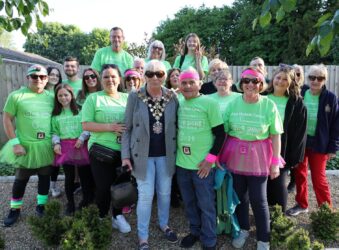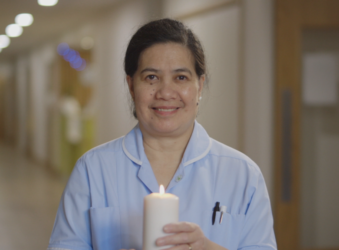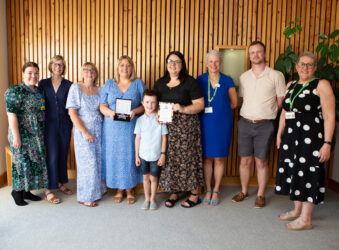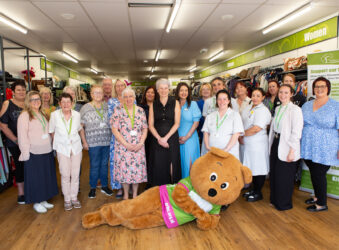An Unexpected Chapter – Hospice at Home
Share this article
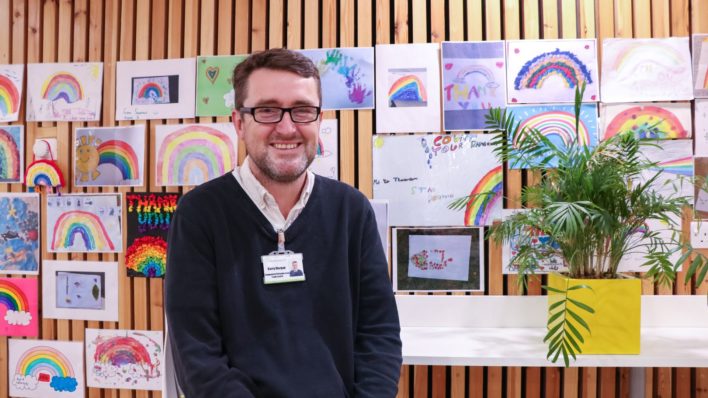
Anyone who has benefitted from our Hospice at Home service, will understand how responsive our team are. Especially when it comes to caring for, and supporting the families of, those at the end of life in their own homes.
However, the need for the team to respond flexibly was taken to a new level in Spring 2020, in response to COVID-19 and related evolving government guidelines.
We spoke to Team Lead Barry Morgan, and reflect on these changes and how our Hospice at Home services have continued to evolve during this ‘Unexpected Chapter’ in our Hospice’s history.
An Unexpected Chapter for Hospice at Home. Part 1 – Keeping our services running
The Hospice at Home team provide specialist hands-on care and support in people’s homes, when they are approaching the end of their life.
This dedicated team, including healthcare assistants and nurses who are experts in the practicalities and complexities of end-of-life care, work closely with GPs, District Nurses and other frontline healthcare providers. Their care and support means that people can die at home if they wish, with their symptoms managed, feeling safe and with their family and loved ones well supported.
The support this team provides also helps reduce potential crisis moments which might otherwise result in hospital admissions by minimising distress (whether that is physical, emotional or psychological) and focusing on quality of life, particularly at the end of life.
We spoke to our Community Team Lead Barry Morgan about what we have done to ensure our vital Hospice at Home service keeps running, since COVID-19 changed everything.
How things used to be…
Before the Coronavirus pandemic things were quite different, in terms of the service as a whole. The team consisted of: three clinical nurse specialists who took calls, advised family members, triaged patients and decided on care allocation for the night; thirteen healthcare assistants (mostly part time) who delivered hands-on care to people in their own homes; two on-call nurses who would visit patients to support with drug administration and any complex issues that needed a registered nurse assessment and one administrator who supported the team overall.
This service has always been in demand and in May 2019 the Hospice launched a Help Us Be There Appeal, to raise funds to help expand the team and address the unmet need. It had been a struggle at points to ensure everyone had the care they needed each night. In the first year the appeal raised over £100,000 – enough to fund 200 additional episodes of care. However, it was clear that much more support was needed to cater for people’s end of life care needs throughout the county.
I joined the team in January 2020. We always intended to evolve the Hospice at Home service significantly in terms of set up and the breadth of the care we are now able to provide, but the pandemic added urgency and momentum.
What has stayed the same…
Some things remain the same. Every referral is still taken on the basis of the patients’ need and the priority of those needs. Every case is looked at individually, to create a palliative care plan that is stable and coordinated with other professionals. Families and patients are at the centre of what we do, and we do our very best to ensure that all the services available to them can be accessed.
Once their personalised palliative care plan is in place, we stay in touch. The level of support is based on what the patients and/or their loved ones need at that time.
For some it might be a regular phone call and check-in. For others they might be at breaking point, and we will send in a healthcare assistant to help support the patient or the wider family. If a healthcare assistant is there overnight, someone who is now a carer for their loved one might be able to have a much-needed night’s sleep, which can go such a long way in helping them cope.
How we’ve adapted…
Expansion – sped up
We had already started to develop plans to expand the geographical reach of the service, as part of a partnership decision to meet the county’s healthcare needs (alongside other Hospices, the Cambridgeshire & Peterborough Clinical Commissioning Group (CCG) and other frontline service providers and coordinators). These plans were fast tracked in April and May, at the point when the virus hit.
The aim was to work in tandem with the healthcare services’ efforts to keep people out of hospital wherever possible and increase the quality of care received at home.
The overarching changes which were part of this expansion are quite significant:
- Provision has been expanded to cover the whole county – including additionally Cambridge City South and East, Huntingdon and the Fens.
- We also now provide daytime as well as overnight care, which makes a huge difference to families at such a critical point.
Recruitment
In order for this expansion to take place, the Charity began recruiting colleagues for the equivalent of fifty full time roles. Some roles are part time, so the influx of new colleagues is even greater than this, and recruitment is on-going.
As you can imagine, as Manager of the team, some things for me are now worlds apart from what they were when I first started the role. Another result of the expansion is that two further Team Leads have been employed, to support our growing Hospice at Home service.
Increasing the number of patients we are able to support
Previously with our old model and before COVID-19, the team was able to support three to eight patients per night dependent on capacity, and this was reviewed every day.
Following the expansion – and in response the county’s frontline healthcare needs that have been so hugely impacted by COVID-19 – we can currently support an average of twenty-five people during the daytime, and an average of six at night. The numbers depend on patient and/or family need and the capacity of our team. We have recruited nearly all the colleagues we need, with a few more roles, including healthcare assistants yet to fill.
Crisis management
One direct result of the pandemic is that more referrals to our team are now happening at a point of crisis, because the normal support systems which would have been in place for patients and their families have closed or become temporarily or permanently inaccessible.
This is compounded by the problem we sometimes encounter, even in normal times, where people are reluctant to ask for help. Or it could be that a patient’s family or the healthcare professionals they are in touch with, not realising how urgent the situation is.
Whatever the surrounding circumstances, there is always a hugely unpredictable nature to palliative care but – even more so than usual, at the moment – crisis management is a key element of our service.
Essential visits only
When the pandemic first broke, we carried on providing our essential visits but made adjustments – like introducing PPE and barrier nursing for all patients in our care. We were very fortunate to be donated PPE as well as receiving all the necessary PPE from the Government in response to the pandemic.
Video assessments, before being referred to Hospice at Home
As the Hospice at Home team’s visits are so critical, these have continued throughout the pandemic and each of the lockdowns.
However, our colleagues in the Specialist Palliative Care Home Team had to adapt to working very differently. Often, they might be the first point of contact for a patient being referred into the Hospice at Home (or another of our services). Each patient, their symptoms, and family and living situations are completely unique. Our care wraps around all of this and the individual person, not just their illness – there is never a one size fits all when it comes to our care.
Previously these initial assessments might have happened in person or over the phone: patients and families find it really reassuring to meet someone in person and often feel more comfortable about asking questions than they do in a video consultation environment. An initial face to face assessment also means our colleagues can observe things about the home environment which we might be able to help with.
When the pandemic first hit, they were no longer able to make home visits. Yet they needed to carry on doing assessments in some form to identify those most in need, on a case-by-case basis. Assessments were therefore restricted to the phone or via video through a secure system.
Innovation and learning…
In order to help with this, the Specialist Palliative Care Home Team were quickly trained in new video technology linked to SystmOne database (the NHS-wide system for patient records). In-house training was provided through video call and guides were provided to follow. The advantage of video over telephone technology is that as well as hearing people and trying to judge a situation from their voice, the team were able to see them and asses them on a more holistic level, for example from their non-verbal signals too.
Another additional advantage of employing this technology is that the Hospice can now reach more patients and families, without increased mileage and costs, making our services more accessible. It also enables us to provide as near to normal service as possible, in these difficult circumstances.
The patient’s point of view…
Patients are feeling the knock-on effect of some GP surgeries and community nursing services being less accessible than they maybe once were. In some cases, this has led to an increased need for Arthur Rank Hospice’s support, where others have not been able to help.
As a result, sometimes our contact with patients starts earlier than it might have done, which is not necessarily a bad thing. Being experts in this field of medicine, it’s sometimes possible for us to intervene sooner that we would have done otherwise. We may be able to help make a patient’s symptoms more manageable, or – for example – refer them or their family to another Arthur Rank Hospice service for further support.
Challenges…
At the start of the pandemic, there were national concerns around whether there was sufficient medical grade PPE. This could have become a huge problem if it had escalated, and whilst I think we would have found a solution, fortunately, this never became an issue for us.
It’s been a challenging time for me too on a personal level. I joined the Hospice and started in this role on the 2 January 2020. I had just newly moved to the area, had a new job and new colleagues. Then COVID-19 happened, just a couple of months later. Everything I, and the team, had planned had to be reshaped.
Day to day priorities changed immediately. Key for me when managing the Hospice at Home team was being present and accessible to them, making sure colleagues were working safely and keeping up with government advice. All whilst providing a vital clinical service which makes a real difference to people when they really need it.
It was a good challenge, because when you work with good people it makes the job so much easier.
A lot of patients and their families have expressed to us that they have felt isolated because of the restrictions within health services. That the Hospice at Home Team were able to carry on giving care and support, in person, has been desperately needed and appreciated.
Opportunities and what’s next for the team…
We hope to finish recruiting in the not too distant future, and with a full expert team on board, will continue to deliver our essential specialist care in every corner of the County.
Palliative Hub
The expansion of Hospice at Home, which was fast-tracked during the pandemic is part and parcel of a larger transformation plan for end-of-life care in our area. Another element of this is the Palliative Care Hub: a new specialist advice and support helpline, commissioned by the Cambridgeshire and Peterborough Clinical Commissioning Group (CCG) and operated by Arthur Rank Hospice Charity in partnership with HUC.
The phone line covers Cambridgeshire and Peterborough and is part of the 111 service, so if patients call 111 and have a palliative diagnosis, they can select option 3 and are put through to the helpline (staffed by clinical nurse specialists) for support.
Eventually the service will be available twenty-four hours a day, seven days a week, to support patients, healthcare professionals and carers looking after patients with life-limiting illnesses. The team provide advice and support where able, signpost to appropriate services, transfer to other healthcare professionals if they can assist or complete necessary referrals to other services.
In this way, the Palliative Care Hub supports the Hospice at Home team, who handle until now have handled a lot of these types of calls day-to-day. Most importantly though, it will be a bridge for people between continuing healthcare referrals and the implementation of a care package. This reduces the likelihood of emergency admissions to hospital, greatly reducing the stress and pressure on carers, and improving the experiences of patients who can be cared for at home, if this is their wish.
I am sure that whatever way we look at it COVID-19 will continue to determine the ways that the Hospice at Home – and wider Arthur Rank Hospice – Team, works for the foreseeable future.
Read ‘An Unexpected Chapter – Inpatient Unit’
Read ‘An Unexpected Chapter – Day Therapy’
Read ‘An Unexpected Chapter – The Patient and Family Support Team’
Read ‘An Unexpected Chapter for our Director of Fundraising and Communications’
Related articles
-

Wisbech’s First Ever Star Shine Night Walk Raises Over £10,000
The community of Wisbech came together for the inaugural Star Shine Night Walk
-

Remember loved ones with Light Up a Life in Cambridge and Wisbech
Light Up a Life Appeal is now open and you are welcome to join us at the events in Cambridge...
-

Hospice Nurses awarded for their outstanding care in the community
Michaela Hill, Gemma Powell and Sarah Pake receive a Cavell Trust Award
-

New Charity Shop opens to support people in the Fenlands
Pop along to the new March Shop and grab a bargain!

